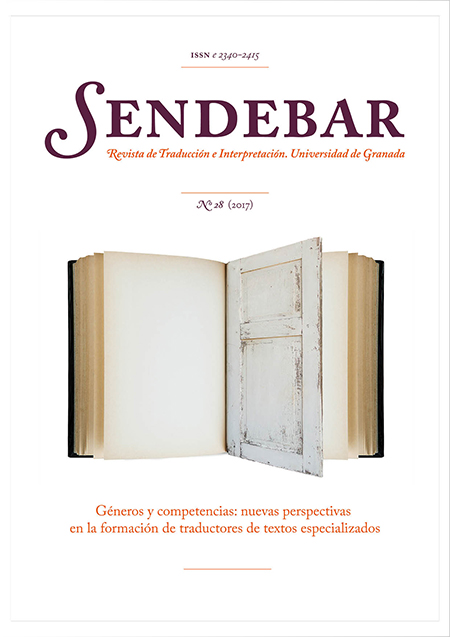Teaching Specialized Translation. Error-tagged Translation Learner Corpora
DOI:
https://doi.org/10.30827/sendebar.v28i0.5419Keywords:
teaching translation, learner corpora, error-tagging, bilingual corpora, corpus-aided language learning, error statisticsAbstract
This paper describes the method used in teaching specialised translation in the English Language Translation Master’s programme at Masaryk University. After a brief description of the courses, the focus shifts to translation learner corpora (TLC) compiled in the new Hypal interface, which can be integrated in Moodle. Student translations are automatically aligned (with possible adjustments), PoS (part-of-speech) tagged, and manually error-tagged. Personal student reports based on error statistics for individual translations to show students’ progress throughout the term or during their studies in the four-semester programme can be easily generated. Using the data from the pilot run of the new software, the paper concludes with the first results of the research examining a learner corpus of translations from Czech into English.
Downloads
References
Bowker, Lynne and Bennison, Peter (2003). Student translation archive: Design, development and application. In Corpora in Translator Education. F. Zanettin, S. Bernardini and D. Stewart (eds.). 103-117. Manchester: St. Jerome.
Castagnoli, Sara, Ciobanu, Dragos, Kunz, Kerstin, Volanschi, Alexandra and Kübler, Natalie (2011). Designing a learner translator corpus for training purposes. In Corpora, Language, Teaching, and Resources: From Theory to Practice. N. Kübler (ed.). 221-248. Bern: Peter Lang.
Driscoll, Margaret (2002). Blended learning: Let’s get beyond the hype. E-learning 1(4), 1-4.
Espunya, Anna (2014). The UPF learner translation corpus as a resource for translator training. Language Resources and Evaluation 48(1). 33-43. doi: 10.1007/s10579-013-9260-1.
Fantinuoli, Claudio and Zanettin, Federico (2015). New Directions in Corpus-Based Translation Studies. Berlin: Language Science Press.
Fictumová, Jarmila and Rambousek, Jiří (2014). Aus den Fehlern anderer lernen. Zur Entwicklung von annotierten Übersetzungslernerkorpora. In Übersetzung als Kulturvermittlung. Translatorisches Handeln. Neue Strategien. Didaktische Innovation (83-100). Bern: Peter Lang.
Fictumová, Jarmila, Kamenická, Renata and Rambousek, Jiří (2014). Translation error typology for quality feedback: Czeching MeLLANGE through HYPAL. In Proceedings of TIFO 2014: Translation and Interpreting Forum Olomouc.
Florén, Cecilia (2006). ENTRAD, an English Spanish parallel corpus created for the teaching of translation. In Proceedings of TALC 2006: 7th Teaching and Language Corpora Conference.
Gale, William A. and Church, Kenneth. W. (1993). A program for aligning sentences in bilingual corpora. Computational Linguistics 19(1). 75–102.
Gallego-Hernández, Daniel (2015). The use of corpora as translation resources: A study based on a survey of Spanish professional translators. Perspectives 23(3). 375-391.
García Izquierdo, Isabel and Conde, Tomás (2012). Investigating specialized translators: Corpus and documentary sources. Iberica 23. 131-156.
Jaaskelainen, Riita and Mauranen, Anna (2005). 5 Translators At Work: A Case Study Of Electronic Tools Used By Translators In Industry. In Meaningful texts: the extraction of semantic information from monolingual and multilingual corpora. Barnbrook, G., Danielsson, P. and Mahlberg, M. (eds.). London: Continuum
Javora, Šimon (2016). Defining an Error Typology. Bachelor Thesis. Masaryk University, Brno.
Kübler, Natalie (2007). The MeLLange learner translator corpus (LTC) [online]. <http://corpus.leeds.ac.uk/mellange/ltc.html>
Kunilovskaya, Maria, Kovyazina, Maria and Ilyushchenya, Tatyana (2014). Error-Tagging in Russian Learner Translator Corpus and Its Classroom Applications. doi:10.13140/RG.2.1.2056.4640
Obrusník, Adam (2013). A hybrid approach to parallel text alignment. Bachelor Thesis. Masaryk University, Brno. <https://is.muni.cz/th/356468/ff_b/?lang=en>
Obrusník, Adam (2014). Hypal: A user-friendly tool for automatic parallel text alignment and error tagging. In Proceedings of the 11th international conference Teaching and Language Corpora.
Štěpánková, Kristýna (2014). Learner Translation Corpus: CELTraC (Czech-English Learner Translation Corpus). Bachelor Thesis. Masaryk University, Brno.
Sosnina, Elena P. (2006). Development and application of Russian Translation Learner Corpus. In Proceedings of the 2006 Corpus Linguistics Conference.
Tamura, Akihiro, Watanabe, Taro and Sumita, Eiichiro (2014). Recurrent Neural Networks for Word Alignment Model. In Proceedings of the 52nd Annual Meeting of the Association for Computational Linguistics (Volume 1: Long Papers). doi:10.3115/v1/p14-1138
Tiayon, Charles (2004). Corpora in translation teaching and learning. Language Matters 35(1). 119-132. doi: 10.1080/10228190408566207.
Uzar, Rafal and Walinski, Jacek (2007). Analysing the fluency of translators. Benjamins Current Topics, 135–145. doi:10.1075/bct.8.12uza.
Varga, Daniel, Németh, Laszlo, Halácsy, Peter, Kornai, Andras, Trón, Viktor and Nagy, Viktor (2005). Parallel corpora for medium density languages. In Proceedings of RANLP 2005: Recent Advances in Natural Language Processing.
Votrubec (Raab), Jiří (2006). Morphological tagging based on averaged perceptron. In Proceedings of WDS´06: Week of Doctoral Students.
Wurm, Aandrea (2013). Eigennamen und Realia in einem Korpus studentischer Übersetzungen (KOPTE). Trans-kom 6(2). <http://www.trans-kom.eu/bd06nr02/trans-kom_06_02_06_Wurm_Eigennamen.20131212.pdf>
Downloads
Published
How to Cite
Issue
Section
License
Terminos de Licencia Sendebar.

















